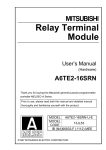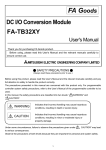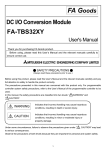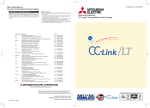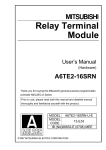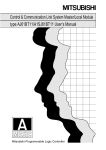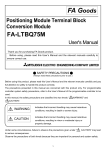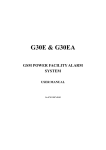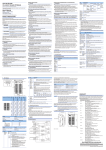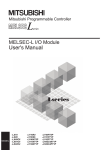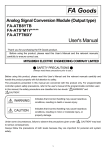Download FA-TH16YRA11S
Transcript
Terminal Module FA-TH16YRA11,FA-TH16YRA11S User's Manual Thank you for purchasing FA Goods product. Before using, please read this User’s Manual and the relevant manuals carefully to ensure correct use. SAFETY PRECAUTIONS (Always read these precautions prior to use.) Before using this product, please read this User’s Manual and the relevant manuals carefully and pay full attention to safety to handle the product correctly. The precautions presented in this manual are concerned with this product only. For programmable controller system safety precautions, refer to the User’s Manual of the programmable controller to be used. In this manual, the safety precautions are classified into two levels: " WARNING" and " CAUTION". WARNING Indicates that incorrect handling may cause hazardous conditions, resulting in death or severe injury. CAUTION Indicates that incorrect handling may cause hazardous conditions, resulting in minor or moderate injury or property damage. Under some circumstances, failure to observe the precautions given under " CAUTION" may lead to serious consequences. Observe the precautions of both levels because they are important for personal and system safety. 1 [Design Precautions] WARNING Configure safety circuits external to the programmable controller to ensure that the entire system operates safely even when a fault occurs in the external power supply or the programmable controller, this product. Failure to do so may result in an accident due to an incorrect output or malfunction. (1) Configure external safety circuits, such as an emergency stop circuit, protection circuit, and protective interlock circuit for forward/reverse operation or upper/lower limit positioning. (2) Outputs may remain on or off due to a failure of an output circuit relay or transistor, triac. Configure an external circuit for monitoring output signals that could cause a serious accident. In an output circuit, when a load current exceeding the rated current or an overcurrent caused by a load short-circuit flows for a long time, it may cause smoke and fire. To prevent this, configure an external safety circuit, such as a fuse. Configure a circuit so that the programmable controller is turned on first and then the external power supply. If the external power supply is turned on first, an accident may occur due to an incorrect output or malfunction. [Design Precautions] CAUTION Do not install the control lines or communication cables together with the main circuit lines or power cables. Keep a distance of 100mm (3.94 inches) or more between them. Failure to do so may result in malfunction due to noise. When a device such as a lamp, heater, or solenoid valve is controlled through an output module, a large current (approximately ten times greater than normal) may flow when the output is turned from off to on. Take measures such as replacing the module with one having a sufficient current rating. 2 [Installation Precautions] WARNING Shut off the external power supply (all phases) before installation. Failure to do so may result in electric shock. [Installation Precautions] CAUTION Use the programmable controller in an environment that meets the general specifications in this User’s Manual. Failure to do so may result in electric shock, fire, malfunction, or damage to or deterioration of the product. Securely fix the module with a DIN rail or mounting screws. Incorrect mounting may cause malfunction, failure or drop of the module. When using this product in an environment of frequent vibrations, fix the module with a screw. Tighten the screw within the specified torque range. Undertightening can cause drop of the screw, short circuit or malfunction. Overtightening can damage the screw and/or module, resulting in drop, short circuit, or malfunction. Shut off the external power supply for the system in all phases before mounting or removing the module. Failure to do so may result in damage to, malfunction, or failure of the product. Do not directly touch any conductive parts and electronic components of this product. Doing so can cause malfunction or failure of the product. [Wiring Precautions] WARNING Shut off the external power supply for the system in all phases before installation and wiring. After wiring, attach the included terminal cover to the module before turning it on for operation. Failure to do so may result in electric shock. 3 [Wiring Precautions] CAUTION Use applicable solderless terminals and tighten them within the specified torque range. If any spade solderless terminal is used, it may be disconnected when the terminal screw comes loose, resulting in failure. Check the rated voltage and terminal layout before wiring to the module, and connect the cables correctly. Connecting a power supply with a different voltage rating or incorrect wiring may cause a fire or failure. Do not install the control lines or communication cables together with the main circuit lines or power cables. Keep a distance of 100mm (3.94 inches) or more between them. Failure to do so may result in malfunction due to noise. Place the cables in a duct or clamp them. If not, dangling cables may swing or inadvertently be pulled, resulting in damage to the module or cables or malfunction due to poor connection. Tighten the terminal screw within the specified torque range. Undertightening can cause short circuit, fire, or malfunction. Overtightening can damage the screw and/or module, resulting in drop, short circuit, or malfunction. Tighten the connector screws within the specified torque range. Undertightening can cause short circuit, fire, or malfunction. Overtightening can damage the screw and/or module, resulting in drop, short circuit, fire, or malfunction. Install the connector to the module securely. Failure to do so may cause malfunction. When disconnecting the cable from the module, do not pull the cable by the cable part. For a cable with connector, hold the connector by hand and pull it out. For a cable connected to a terminal block, loosen the terminal block screws first before removing the cable. Failure to do so may result in malfunction and damage to the module or cable. Before connecting the cables, check the type of interface to be connected. Connecting or erroneous wiring to the wrong interface may cause failure to the module and external devices. Prevent foreign matter such as dust or wire chips from entering the module. Such foreign matter can cause a fire, failure, or malfunction. This product must be installed to control panels. Connect the main power supply to this product in the control panel through a relay terminal block. Wiring and replacement of a this product must be performed by qualified service personnel who is familiar with protection against electric shock. When connecting programmable controller, check that the product configuration are correct. The modules may be failure or malfunction if the configuration is incorrect. Install the device in the unit surely. It causes the malfunction by damage, the drop, and the poor contact if not correctly installed. Moreover, mounting or removing the module it according to a correct procedure. It causes the malfunction by damage, the drop, and the poor contact if not correctly mounting or removing the module. Use it with power doesn't join the connector of this product. Failure or disconnection may cause malfunction. Prevent foreign matter such as dust or wire chips from entering the product. Such foreign matter can cause a fire, failure, or malfunction. 4 [Startup and Maintenance Precautions] WARNING Do not touch any terminal while power is on. Doing so will cause electric shock or malfunction. Shut off the external power supply for the system in all phases before cleaning the module or retightening the terminal screws, connector screws, or module fixing screws. Failure to do so may result in electric shock or cause the module to fail or malfunction. Undertightening can cause drop of the screw, short circuit or malfunction. Overtightening can damage the screw and/or module, resulting in drop, short circuit, or malfunction. [Startup and Maintenance Precautions] CAUTION Do not disassemble or modify the modules. Doing so may cause failure, malfunction, injury, or a fire. Use any radio communication device such as a cellular phone or PHS (Personal Handy phone System) more than 25cm (9.85 inches) away in all directions from the programmable controller, this product. Failure to do so may cause malfunction. Shut off the external power supply for the system in all phases before mounting or removing the module. Failure to do so may cause the module to fail or malfunction or damage. After the first use of the product, do not mount/remove the module, and the cable more than 50 times (IEC 61131-2 compliant) respectively. Exceeding the limit of 50 times may cause malfunction. Startup and maintenance of a control panel must be performed by qualified maintenance personnel with knowledge of protection against electric shock. Lock the control panel so that only qualified maintenance personnel can operate it. Before handling the module, touch a grounded metal object to discharge the static electricity from the human body. Failure to do so may cause the module to fail or malfunction. [Disposal Precautions] CAUTION When disposing of this product, treat it as industrial waste. [Transportation Precautions] CAUTION The shock that exceeds the range of the general specification during transportation must avoid this product for the precision instrument. Doing so results in the risk of failure. 5 1.INTRODUCTION This User’s Manual describes the specifications and so on for terminal module used in combination with Mitsubishi Electric Corporation DC output modules. 2.GENERAL SPECIFICATIONS Item Specifications Operating Surrounding air temperature 0 to 55°C Storage ambient temperature -25 to 75°C Operating ambient humidity 5 to 95% RH, no condensation Storage ambient humidity 5 to 95% RH, no condensation Compliant standards Under Vibration resistance intermittent vibration Under continuous vibration Shock resistance JIS B 3502, IEC61131-2 Frequency Acceleration Amplitude Sweep count 10 to 57Hz ― 0.075mm 10 times each in X, Y, and Z axis directions 2 57 to 150Hz 9.8m/s (1G) ― 10 to 57Hz ― 0.035mm 57 to 150Hz 4.9m/s2 (0.5G) ― ― Conforms to JIS B 3502 and IEC61131-2 (147m/s2 (15G), 3 times each in X, Y, and Z axis directions) Operating atmosphere There should be no corrosive gases. Operating altitude (* 1) 2,000m or lower Installation location Inside control panel Overvoltage category (* 2) II or lower Pollution level (* 3) 2 or lower * 1: Do not use or store in a pressurized environment greater than the atmospheric pressure at an altitude of 0m. * 2: Indicates how an assumption has been made on the point at which the devices are connected from the public power grid to the machinery and equipment inside the facilities. * 3: This is a guideline indicating the extent to which conducting substances are found in the environment in which the devices are used. 6 3.PERFORMANCE SPECIFICATIONS 3-1. Module specifications Model name FA-TH16YRA11 Item Number of I/O points I/O device numbers Insulation type Rated switching voltage/current Max. number of contacts simultaneously ON Min. switching load Max. switching load Max. switching frequency Mechanical life Electrical life Response time OFF→ON ON→OFF Common method External supply power Unit consumption current Dielectric withstand voltage, insulation resistance Withstand noise Operation indication Sockets Device exchange count Device mixing Terminal block Terminal block screws Applicable wire Module mounting Mounting screws DIN rail Weight FA-TH16YRA11S 16 points, Y0 to YF Relay Voltage: 24 VDC, 200 VAC (50/60Hz), (* 4) Current: 2A/1 contact (resistance load, COSø=1), 8A/1 common 100% DC5V 1mA AC270V,DC150V 1,800 times/hr (ON 1 second or longer, OFF 1 second or longer) 20,000,000 times or more 100,000 times or more at rated switching voltage and current 100,000 times or more at 200 VAC 1.5A (COSø=0.7), 240 VAC 1A (COSø=0.7) 100,000 times or more at 200 VAC 1A (COSø=0.35) 100,000 times or more at 24 VDC 1A (L/R=7ms), 100 VDC 0.1A (L/R=7ms) 10 ms or less (exc. PLC response time) 12 ms or less (exc. PLC response time) 16 contacts, 1 common (1 wire system) 24 VDC ±10% (ripple factor within 5%, CLASS 2) Approx. 90mA when 24 VDC (not inc. PLC consumption current) Between inputs/outputs: 2500 VAC 1 minute, between contacts: 750 VAC 1 minute, 10MΩ or higher Simulator noise 1500 Vp-p, noise width 1 μs (based on noise simulator with noise frequency of 25 to 60Hz) LED indicator display when power ON, inputs ON None (device exchange not possible) Yes (relay device exchange possible) ― 50 times ― Device mixing not possible M3 screw, Number of terminals:20P, Pitch of 7.62mm, Self tightening screw with finger protector cover Terminal screw tightening torque range: 58.8 to 88.2N・cm (6 to 9kgf·cm) 2 Applicable wire: 0.5 to 1.25mm M4 × 0.7mm × 22mm or greater Tightening torque range: 78 to 118N·cm (8 to 12kgf·cm) Applicable DIN rail: TH35-7.5Fe, TH35-7.5Al (conform to JIS C 2812) About 220g About 240g * 4: Evaluation for UL certification is conducted under resistance load conditions. 3-2. Characteristics data of used relay 3-2-1.Maximum value of switching capacity 3-2-2.A contact life curve Note 1:When used in applications having a high switching frequency, the life of the relays is a problem. For this reason, we recommend studying use of triac output terminal module. Note 2:The relay life curves show performance values and are not guaranteed values. For this reason, consider providing sufficient margin for relay life curves. Note 3:The life of relays changes considerably by the type of load and the characteristics of its inrush current. In particular, inrush current causes fusing of contacts. For this reason, take rush current as well as steady current into consideration. (a)Inductive load When an inductive load such as a magnetic switch or solenoid is shut off, a high electromotive force occurs between contacts to generate arc discharge. In particular, attention is required as life is shortened when the power factor is small. Also, when power is turned ON, fusing of contacts must be taken into consideration as a rush current of 5 to 15 times the regular current flows. (b)Lamp load Fusing of contacts must be taken into consideration in lamp circuits as a rush current of 10 to 15 times the regular current flows. (c)Capacitive load When the load circuit contains a capacitor, an inrush current of 20 to 40 times the regular current sometimes flows, so fusing of contacts must be taken into consideration. Attention is also required to the wire capacitance when routing wiring a long distance. 7 4.CONNECTED TARGET MODEL / PLC MODULE,CONNECTION CABLE PLC Module Model (Note 5) MELSEC-Q Series terminal block type MELSEC-Q Series connector type QY40P QY41P QY42P FA-CBLFM2V (Note 4) FA-CBLFM2LV (Note 4) QH42P QX41Y41P MELSEC-L Series connector type Connection Cable Model FA-CBLM20 FA-CBLYM20 FA-CBLTMV20 Module Model FA-CBLFM2V (Note 4) FA-CBLFM2LV (Note 4) Output side LY41NT1P LY42NT1P FA-CBLFM2V (Note 4) FA-CBLFM2LV (Note 4) FA-TH16YRA11 FA-CBLFM2V (Note 4) FA-TH16YRA11S FA-CBLFM2LV (Note 4) A1SY41P A1SY42P MELSEC-AnS Series connector type A1SH42 A1SH42-S1 A1SH42P A1SH42P-S1 CC-Link connector type AJ65SBTCF1-32T AJ65BTC1-32T FA-CBLFM2H (Note 4) FA-CBLFM2LH (Note 4) CC-Link/LT connector type CL2Y16-TP1M1V FA-CBLMMH20 FA-CBLFM2V (Note 4) FA-CBLFM2LV (Note 4) Output side Note 4: Two connected units must use the same power supply. Note 5: It is not possible to use it excluding 24DCV. 5.EXTERNAL DIMENSIONS FA-TH16YRA11,FA-TH16YRA11S [Unit: mm] 6.MODULE MOUNTING ORIENTATION Horizontal mounting Vertical mounting 8 7.INSTALLATION METHOD 7-1.Connection example with terminal block PLC module 7-1-1.When cable with terminal block is used. Attach the terminal block securely to the PLC module with attachment screws. Programmable controller module QY40P Connection cable FA-CBL**TMV20 Insert the connector to the back, and then fully secure the connector with a clip. Load 9 7-1-2.When rose line cable is used. Attach the power wires securely to the PLC module terminal block Programmable controller module QY40P Connection cable FA-CBL**M20 FA-CBL**YM20 Insert the connector to the back, and then fully secure the connector with a clip. Load 10 7-2.Connection example with PLC connector module 7-2-1.When 40P connector cable is used. Insert the connector to the back, and then fully install the connector to the programmable controller module using the mounting screws. Programmable controller module QY41P, other Connection cable FA-CBL**FM2V FA-CBL**FM2LV FA-CBL**DM2FY FA-CBL**FM2H FA-CBL**FM2LH Insert the connector to the back, and then fully secure the connector with a clip. Insert the connector to the back, and then fully secure the connector with a clip. Load Load 11 7-2-2.When 20P connector cable is used. CC-Link/LT remote I/O, CL2Y16-TP1M1V Insert the connector to the back, and then fully secure the connector with a clip. Connection cable FA-CBL**MMH20 Load 12 8.EXTERNAL CONNECTION EXAMPLE Note 6 Note 6: The capacitor is not mounted on FA-TH16YRA11. 9.HOW TO DISMOUNT AND SET THE DEVICE REMOVE 13 10.APPLICABLE CRIMPING TERMINALS ● Size of crimping terminal [Unit:mm] Size of crimping terminal ● Terminal trapezoid A B MIN 5.0 MAX 6.3 [Unit:mm] 14 FOR YOUR SAFETY This product has been manufactured as a general-purpose product for general industry applications, etc. The product is not intended for use in devices or systems used under conditions in which human life could be greatly affected. When considering application of this product to special applications, such as nuclear power, electrical power, aerospace, medical, or manned transport devices or systems, contact our sales service desk. Although this product was manufactured under a strict quality management system, the product shall be systematically provided with backup and fail-safe functions when applied to equipment that may lead to a major accident or damage in the unlikely event any failure or defect should occur in the product. 1-13-5 Kudankita, Chiyoda-ku, Tokyo, Japan 102-0073 Homepage URL: http://www.mee.co.jp/ Direct any technical inquiries to: Nagoya office (PC Engineering Dept.) Phone: +81 (52) 723-8058 Fax: +82 (52) 723-8062 During product use, be sure to ensure safety in the unlikely event failure occurs. Mitsubishi Electric Engineering assumes no responsibility whatsoever for any secondary damage caused by the failure of this product. 50D-FA9010-022 Information such as specifications is subject to change without notice. Developed September 2011 15


















